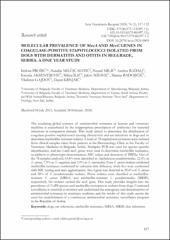Molecular prevalence of MecA and MecC genes in coagulase-positive staphylococci isolated from dogs with dermatitis and otitis in Belgrade, Serbia: a one year study

View/
Date
2024Author
Prošić, Isidora
Milčić-Matić, Natalija
Milić, Nenad
Radalj, Andrea
Aksentijević, Ksenija
Ilić, Milica
Nišavić, Jakov
Radojičić, Marina
Gajdov, Vladimir
Krnjajić, Dejan
Metadata
Show full item recordAbstract
The escalating global concern of antimicrobial resistance in human and veterinary medicine is exacerbated by the inappropriate prescription of antibiotics for bacterial infections in companion animals. This study aimed to determine the distribution of coagulase-positive staphylococci causing clinical skin and ear infections in dogs and to determine methicillin-resistant isolates. A total of 78 staphylococcal strains were isolated from clinical samples taken from patients at the Dermatology Clinic at the Faculty of Veterinary Medicine in Belgrade, Serbia. Multiplex PCR was used for species-specific identification, and mecA and mecC genes were used to determine methicillin resistance, in addition to phenotypic determination, MIC values and detection of PBP2a. Out of the 78 samples analyzed, 65.8% were identified as Staphylococcus pseudintermedius, 22.4% as S. aureus, 7.9% as S. coagulans, and 3.9% as S. intermedius. Four S. aureus isolates exhibited methicillin resistance confirmed by cefoxitin disk diffusion, while five were confirmed with MIC testing and latex agglutination. MecA gene was detected in 29.4% of S. aureus and 30% of S. pseudintermedius isolates. These isolates were classified as methicillinresistant S. aureus (MRSA) and methicillin-resistant S. pseudintermedius (MRSP), respectively. No isolates carried the mecC gene. This study provides insights into the prevalence of CoPS species and methicillin resistance in isolates from dogs. Continued surveillance is essential to monitor and understand the emergence and dissemination of antimicrobial resistance in veterinary medicine and the results of this study accent the need for establishment of a continuous antimicrobial resistance surveillance program in the Republic of Serbia.
